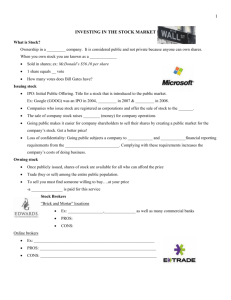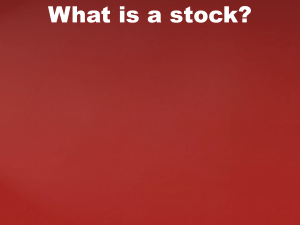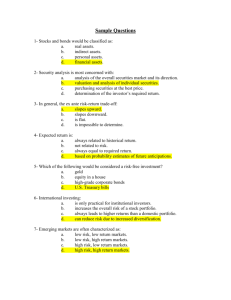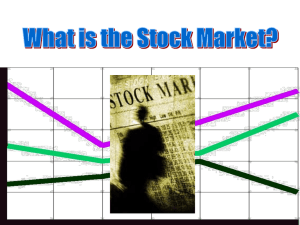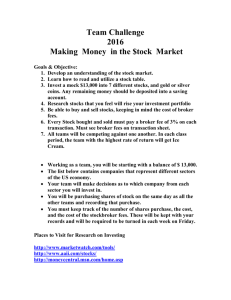StockMarketPacket
advertisement
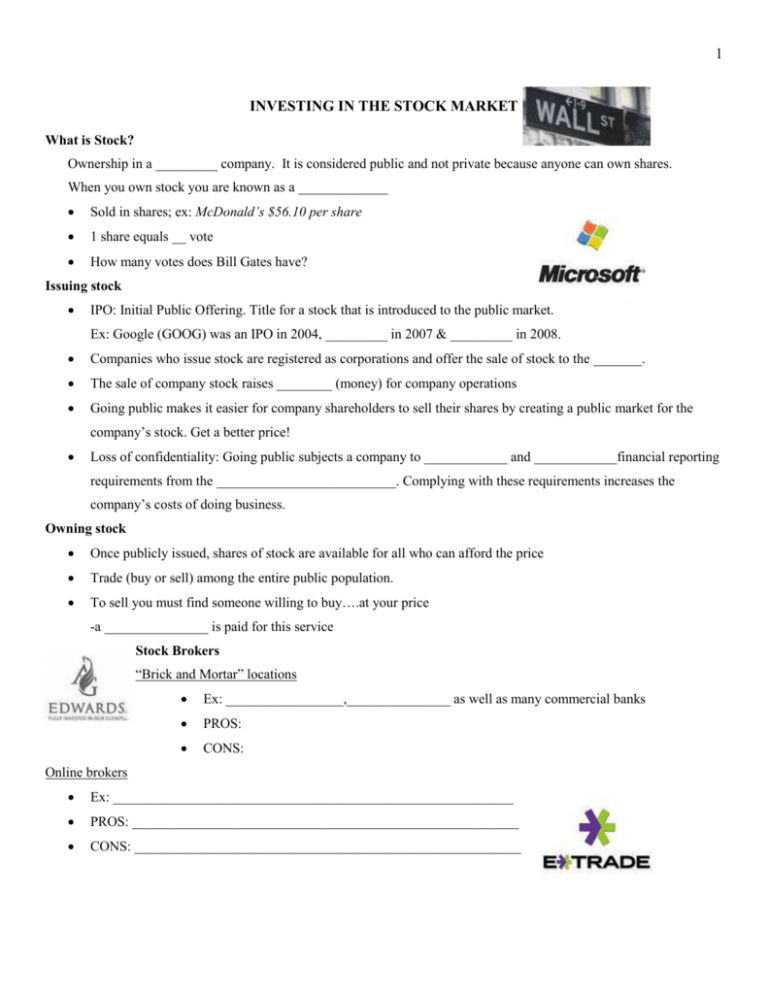
1 INVESTING IN THE STOCK MARKET What is Stock? Ownership in a _________ company. It is considered public and not private because anyone can own shares. When you own stock you are known as a _____________ Sold in shares; ex: McDonald’s $56.10 per share 1 share equals __ vote How many votes does Bill Gates have? Issuing stock IPO: Initial Public Offering. Title for a stock that is introduced to the public market. Ex: Google (GOOG) was an IPO in 2004, _________ in 2007 & _________ in 2008. Companies who issue stock are registered as corporations and offer the sale of stock to the _______. The sale of company stock raises ________ (money) for company operations Going public makes it easier for company shareholders to sell their shares by creating a public market for the company’s stock. Get a better price! Loss of confidentiality: Going public subjects a company to ____________ and ____________financial reporting requirements from the __________________________. Complying with these requirements increases the company’s costs of doing business. Owning stock Once publicly issued, shares of stock are available for all who can afford the price Trade (buy or sell) among the entire public population. To sell you must find someone willing to buy….at your price -a _______________ is paid for this service Stock Brokers “Brick and Mortar” locations Ex: _________________,_______________ as well as many commercial banks PROS: CONS: Online brokers Ex: __________________________________________________________ PROS: ________________________________________________________ CONS: ________________________________________________________ 2 Two ways to make money on stocks 1. Capital Gains: Profit earned from the sale of stock Buy low sell high Ex: bought 10 shares of XYZ co. @ $10 = $100; sold 10 shares of XYZ co. @ $12 = $120. profit of $ ________ . 2. Dividends Percent of company profit paid to shareholders Dollar amount paid varies depending on stock price Ex: XYZ co. pays a 5% dividend, stock price is $100, you own 10 shares; $100 X .05 = $5; 10 shares X $5 per share=$50 What affects prices? Supply & Demand-greatest determinant Supply: number of _________________ Demand: number of people ___________ and __________ to buy the stock o Is the stock affordable? o You may want to buy Google but can you afford to pay $_______ per share? Company news: mergers, acquisitions, new products, layoffs, recalls, lawsuits, resignations o Public image-good or bad? o Ex: Merck’s Vioxx recalled & lost $253.4M lawsuit (Aug. 2005) o stock dropped from $31 to $28, a 10% decrease. Enron: Securities Exchange-where buyers and sellers meet to _________ securities. NYSE: __________________________________ Largest U.S. exchange Companies listed: _________,______________,_____________,___________ NASDAQ (National Association of Securities Dealer’s Automated Quotations) Computerized system that displays quotes Companies listed: ___________,_____________________,________________ -How are NASDAQ and NYSE stocks different? Smaller exchanges exist in various cities; Chicago, Cincinnati, Denver, Salt Lake 3 Stock Indexes-used to judge the performance of investments or a group of investments Dow Jones Industrial Average (^DJI) a.k.a. the DOW ___ large, actively traded blue-chip stocks from the NYSE Primarily industrial companies yet now more diversified Listed stocks change based on performance o Recent stocks removed: o Recent stocks added: Used as the major gauge to judge the overall performance of the market S & P 500 _______ widely held companies S & P stands for: ___________________________________ NASDAQ Composite Index. _________________ exchange contains mostly Stands for: Stock Market Cycles Bear Market Prolonged period of falling stock prices Often associated with overall _______________ in the country & stock market Bull Market period of charging, __________ prices is often associated with an overall _______________ in the country & stock market Type of Stock Common Stock: ________ gains; pays _________ dividend (depends on _________ of the stock); Carries _____ rights Preferred Stock: __________ gains; Pays fixed dividend (often lower than common); Carries no voting rights Less risk-if company fails, preferred stockholders are paid off before common. Blue Chip: Penny Stocks: Growth Stocks: Income Stocks: 4 McDonald’s Stock Price and Information MCDONALDS CORP (NYSE:MCD) Last Trade: 29.74 Day's Range: 29.73 - 29.74 Trade Time: 9:31AM ET 52wk Range: 23.01 - 29.98 Volume: 149,500 0.11 (0.37%) Change: Prev Close: 29.63 Avg Vol (3m): 3,893,804 Open: 29.74 Market Cap: 37.36B Bid: N/A P/E (ttm): 21.36 Ask: N/A EPS (ttm): 1.392 1y Target Est: 33.79 0.55 (1.86%) Div & Yield: Fiscal Year Ends: 31-Dec Most Recent Quarter (mrq): 30-Sep-08 Annual Dividend: 0.55 Shares Outstanding: 1.26B Dividend Yield: 1.86% Beta: 0.772 Dividend Date: 1-Dec-08 Revenue (ttm): Last Split Factor (new per old)²: 2:1 Profit Margin (ttm): Last Split Date: 08-Mar-99 Key Terms Last Trade Bid/Ask: Ticker Symbol: 52 week range: EPS: P/E ratio: -Circle one: The lower/higher the better? Market Capitalization: Small cap: under $______________ Example: Mid cap: between $_____________ and $____________ Example: Large cap: over $_______________ Example: Shares Outstanding: Volume: Dividend & Dividend Yield: Stock Split Beta: 18.19B 9.76% 5 Stock Classifications Blue Chip: Larger well-known & established corporations, very unlikely to fail. Low risk = low, steady return. Ex: Proctor & Gamble (PG), Johnson & Johnson (JNJ), Coke (KO), Income stocks History of paying high dividends Few profitable investment opportunities Ex: citigroup, BP, Bank of America Growth Stocks Profits reinvested to help business grow Are purchased by investors for future capital gain Ex: urban outfitters (urbn), panera bread (pnra) Penny Stocks Sell for less than a $5 (by Wall Street definition) All traded on OTC (over-the-counter) markets by phone or computer, such as the NASDAQ. Very risky yet high possibility for return. Ex: eToys.com (ETYS) is at $3.81; CBS MarketWatch (MKTW) at $4.53 Securities Exchange-where buyers and sellers meet to trade securities. NYSE (New York Stock Exchange) Largest U.S. exchange Must meet minimum number of shares and market cap. requirements Companies listed: Pepsi, McDonalds, GE, Johnson & Johnson NASDAQ (National Association of Securities Dealer’s Automated Quotations) Computerized system that displays quotes Must have 100,000 shares and worth $1 million Companies listed: Microsoft, Cisco, Google Smaller exchanges exist in various cities; Chicago, Cincinnati, Denver, Salt Lake Stock Indexes-used to judge the performance of investments or a group of investments Dow Jones Industrial Average (^DJI) a.k.a. the DOW 30 large, actively traded blue-chip stocks from the NYSE Primarily industrial companies yet now more diversified Listed stocks change based on performance 6 Used as the major gauge to judge the overall performance of the market S & P (Standard and Poor’s) 500 500 widely held companies NASDAQ Composite Index Stock Market Cycles Bear Market Prolonged period of falling stock prices Often associated with overall pessimism in the country Bull Market period of charging, rising prices is often associated with an overall confidence in the country Other Investment Methods Dollar Cost-Averaging Purchase the same dollar amount of shares (ex: $100 worth) at regular intervals Investors don’t have to worry about timing the market Usually averages out to paying less per share than the average share price. DRP (Dividend reinvestment Plan) Use dividends to reinvest and buy stocks directly from the company Avoid brokerage and other processing fees Buying on Margin Borrowing money from the broker to buy more stock than you can afford You are betting the stock will go up Pay interest to your broker on the amount borrowed Short-Selling Selling stock borrowed from a broker that must be replaced at a later time. You are betting the price will drop and then you can buy back at a lower price No broker fee for selling short-just the normal trading commission Other terms Portfolio: the group of holdings or stocks Diversification: spreading risk by investing in different industries, markets or in both stocks, bonds, savings accounts and cash. Sector: refers to putting stocks into different categories or sectors based on their industry. -Ex: food & beverage, transportation, aerospace 7 Stock Spilt: split outstanding shares into more shares. Creates more shares at a lower price. -Ex: KO 2 for 1 (1996) GE 3 for 1, (2000); MSFT 3 for 2 (1991) Reverse Spilt: reverses the number of shares so there are less outstanding shares at a higher price. -Ex: PlanetRX.com (PLRX), for example, has traded below 50 cents a share for weeks and is planning an 8-for-1 reverse split to hike its stock price. P/E ratio: Price of the stock divided by the earnings per share (eps). Used as a gauge to determine if the stock is over/undervalued. Lower P/E the better.


